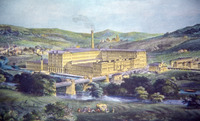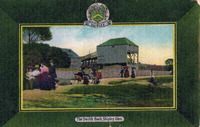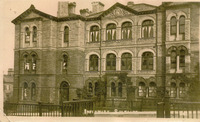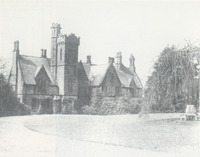Places
Item set
- Identifier
- COL44
- Title
- Places
- Description
- Names of places associated with an item, such as the place of creation, or of use.
- Type
Items
-
 Salts Mill, Saltaire, West Yorkshire, United Kingdom The first building to be constructed in Saltaire, Salts Mill was designed to manufacture textiles on a truly industrial scale. Titus Salt’s intention was to incorporate all elements of the manufacturing process under one roof, rather than each taking place at a separate location as his previous mills in Bradford required.Employing around 4000 workers, the Mill was the very heart of Saltaire. Part of Salt’s motivation to build Saltaire was his concern over the pollution and living conditions in Bradford. To prevent Saltaire suffering the same issues, each of the chimneys was fitted with an early device to remove pollutants from smoke. The Mill changed hands many times over the years. Following the collapse of the textile industry in West Yorkshire, processes were gradually moved out of the Salts Mill building. In 1985, the last processes were relocated, and the empty mill put up for sale. In 1987, Jonathan Silver purchased the Mill and refurbished it into the building we see today. Rather than a single manufacturing centre, the Mill is both the site of multiple new businesses and a cultural hub with shops, an art gallery and restaurant.
Salts Mill, Saltaire, West Yorkshire, United Kingdom The first building to be constructed in Saltaire, Salts Mill was designed to manufacture textiles on a truly industrial scale. Titus Salt’s intention was to incorporate all elements of the manufacturing process under one roof, rather than each taking place at a separate location as his previous mills in Bradford required.Employing around 4000 workers, the Mill was the very heart of Saltaire. Part of Salt’s motivation to build Saltaire was his concern over the pollution and living conditions in Bradford. To prevent Saltaire suffering the same issues, each of the chimneys was fitted with an early device to remove pollutants from smoke. The Mill changed hands many times over the years. Following the collapse of the textile industry in West Yorkshire, processes were gradually moved out of the Salts Mill building. In 1985, the last processes were relocated, and the empty mill put up for sale. In 1987, Jonathan Silver purchased the Mill and refurbished it into the building we see today. Rather than a single manufacturing centre, the Mill is both the site of multiple new businesses and a cultural hub with shops, an art gallery and restaurant. -
Scarborough, North Yorkshire, United KingdomScarborough is a seaside town on the east coast of Yorkshire. Scarborough was a traditional fishing village which became a popular seaside holiday destination during the nineteenth century, particulary for workers from West Yorkshire. Scarborough was the home of the Congregationalist minister the Reverend Robert Balgarnie, a friend of Sir Titus Salt who wrote the first biography of the Salt.
-
Settle, North Yorkshire, United KingdomMarket town in North Yorkshire
-
Sheffield, South Yorkshire, United KingdomSheffield is a major city in South Yorkshire. Sheffield played a major role during the Industrial Revolution particularly for its steel-based manufacturing.
-
 Shipley Glen, Shipley, West Yorkshire, United Kingdom A green space of woods and open moorland on the valley side to the North of Saltaire. In the later nineteenth century it became the site of pleasure grounds including a toboggan run, switchback roller coaster and other amusements. It was very popular with the residents of nearby Saltaire, Shipley and Baildon as a place of recreation.
Shipley Glen, Shipley, West Yorkshire, United Kingdom A green space of woods and open moorland on the valley side to the North of Saltaire. In the later nineteenth century it became the site of pleasure grounds including a toboggan run, switchback roller coaster and other amusements. It was very popular with the residents of nearby Saltaire, Shipley and Baildon as a place of recreation. -
Shipley, West Yorkshire, United KingdomTown in West Yorkshire about 3 miles west of Bradford. Became heavily industrialised and expanded rapidly during the nineteenth century. Saltaire was built about 1 mile to the West of the town centre. Saltaire has always been part of Shipley for local government purposes.
-
 Sir Titus Salt's Hospital building, Saltaire, West Yorkshire, United Kingdom Titus Salt built an infirmary in Saltaire to care for the village residents. It had enough wards and beds for 27 patients, a dispensary and a surgery for treating workers injured in Salts Mill. The hospital was taken over by the NHS in 1948. It was sold in 1974 and became a private nursing home. It has since been converted to private residences.
Sir Titus Salt's Hospital building, Saltaire, West Yorkshire, United Kingdom Titus Salt built an infirmary in Saltaire to care for the village residents. It had enough wards and beds for 27 patients, a dispensary and a surgery for treating workers injured in Salts Mill. The hospital was taken over by the NHS in 1948. It was sold in 1974 and became a private nursing home. It has since been converted to private residences. -
Skegness, Lincolnshire, United KingdomSkegness is a coastal town in Lincolnshire. In the nineteenth century Skegness bercame a popular seaside holiday destination for people from West Yorkshire.
-
Slaithwaite, West Yorkshire, United KingdomSlaithwaite is a town in West Yorkshire about 8 miles from Huddersfield. It was the location for several textile businesses from the nineteenth century onwards. Slaithwatie was the birth place of Donald Hanson, one of the last managing directors of Salts Mill as a textile factory.,
-
St Leonards-on-Sea, East Sussex, United KingdomSeaside resort in southern England. Location of a school attended by Shipley textiles businessman, MP and philanthropist SIr Norman Rae.
-
 Stables building, Saltaire, West Yorkshire, United Kingdom Originally the stables for Salts Mill. Now converted to residences.
Stables building, Saltaire, West Yorkshire, United Kingdom Originally the stables for Salts Mill. Now converted to residences. -
Stafford, Staffordshire, United KingdomStafford is a market town and the county town of Staffordshire in the English midlands.
-
Stoke-on-Trent, Staffordshire, United KingdomStoke-on-Trent is a city in Staffordshire in the English midlands. During the Industrial Revolution it became a centre for the pottery production.
-
Stornoway, Western Isles, United KingdomStornoway is the largest town on the island of Lewis in the Outer Hebrides, off the West coast of Scotland. Sir Titus Salt paid for the first lifeboat to be stationed there.
-
Strathallan Castle, Perthshire, United KingdomStrahallan Castle was purchased by Sir James Roberts in 1910. Sir James offered the castle for use during the First World War, and it was used a a Red Cross convalescent hospital. Durng the Second World War it temporarily hosted a Glasgow girls school that had been moved for safety. Today the castle is still home to some of Sir James's descendants.
-
Stromness, Orkney, United KingdomStromness is the second largest town in the Orkney Islands off the north coast of Scotland. The first lifeboat station in the Orkneys was opened here in 1867. Sir Titus Salt gave money for the purchase of a 33 foot (10 metre), 10-oared wooden lifeboat.
-
Stroud, Gloucestershire, United KingdomStroud is a market town in Gloucestershire in the south west of England.
-
Thackley, West Yorkshire, United KingdomThackley is a suburb of Bradford near to Shipley.
-
 The Knoll, Baildon, West Yorkshire, United Kingdom The Knoll was a grand mansion in Baildon, near Saltaire. It was built as the home of Charles Stead, a member of the board of Sir Titus Salt Bart. Sons and Company Limited. James Roberts later acquired the house in the early twentieth century. The house was demolished in the early 1960s.
The Knoll, Baildon, West Yorkshire, United Kingdom The Knoll was a grand mansion in Baildon, near Saltaire. It was built as the home of Charles Stead, a member of the board of Sir Titus Salt Bart. Sons and Company Limited. James Roberts later acquired the house in the early twentieth century. The house was demolished in the early 1960s. -
Thorp Arch, West Yorkshire, United KingdomThorp Arch is a village near Weherby and Leeds in West Yorkshire. It is the site of a home rented by Catherine Salt.
Catalogue data (excluding media) available under Creative Commons Attribution-ShareAlike (CC BY-SA 4.0) licence.